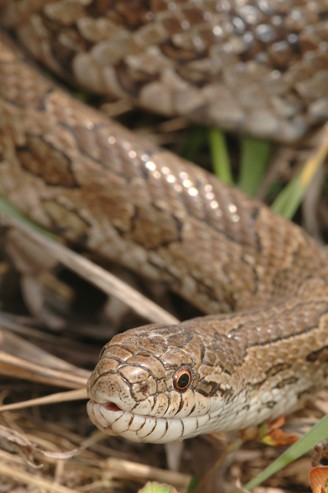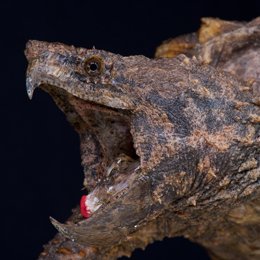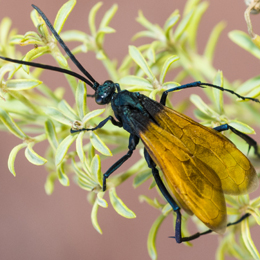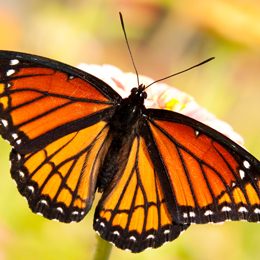Physical Description
Commonly referred to as the Prairie Kingsnake, this species of non-venomous snakes is found primarily in North America. The habitat range includes states like Nebraska, Florida, Texas and Virginia. The snake is a medium sized species that has a rounded head, robust body and a relatively short tail. There are three recognized subspecies of the Prairie Kingsnake: Mole Kingsnake, Prairie Kingsnake and the South Florida Mole Kingsnake. The average length of the species is around 76 – 102 cm (2.5 – 3.3 ft) and weighs about 1 – 1.5 kg (2.2 – 3.3 lbs).
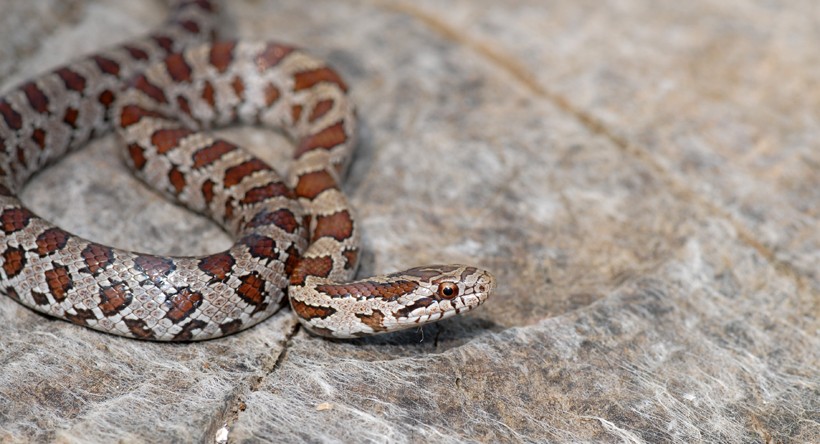
Prairie Kingsnake on an old stump
?
Image credits: Rusty Dodson/Shutterstock
The snake is characterized for its dark gray, brown or reddish brown blotches that run down its body length. It is typically light brown or gray in color with an evenly toned body although some specimens may have faded blotches. Not much is known about the species but it is often mistaken for a species of rat snakes because of the physical markings and similar habitat. There are two black spots located behind the head and smaller black spots present along both sides of the stripes. All three subspecies showcase a light brown body with reddish brown to gray blotches, a pale cream or yellowish colored belly with darkened blotches. The subspecies can be differentiated based on their coloration and scale counts. Usually, the top of the head has a backward pointing arrow shaped marking.
Habitat
The Prairie Kingsnake can be found in grasslands but is also prominent around the edges of crop fields, hay fields and coffee plantations. They generally reside on rocky hillsides or can be found on woodlots, old rock walls and near farm buildings. Prairie kingsnakes generally take shelter inside mammal burrows, located near riverside plantations and open grasslands. They prefer land where the soil is loose, dry or on the edge of a forested region which isn’t far from a source of water. These snakes are secretive animals that generally retreat beneath rocks or rabbit holes although they can easily hide within pastures.
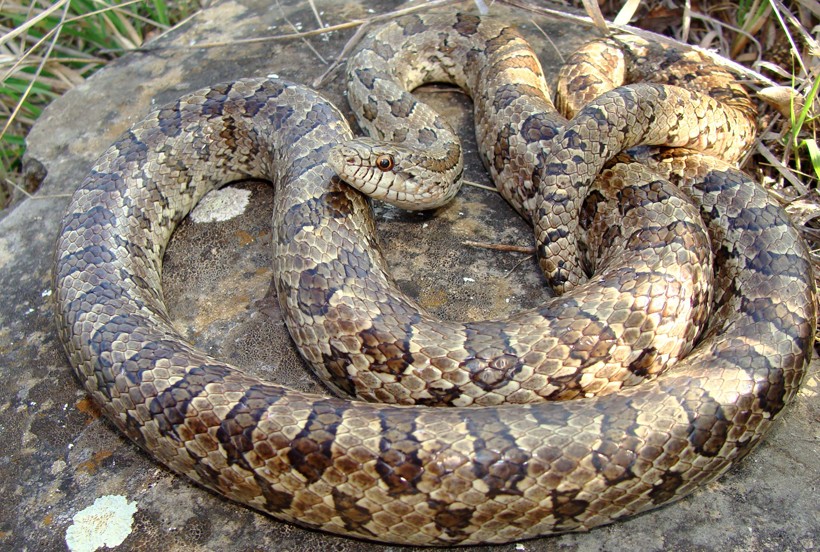
Prairie Kingsnake basking on a rock
?
Image credits: Matt Jeppson/Shutterstock
Subspecies & Distribution
The three subspecies of the Prairie Kingsnake are located in distinct regions:
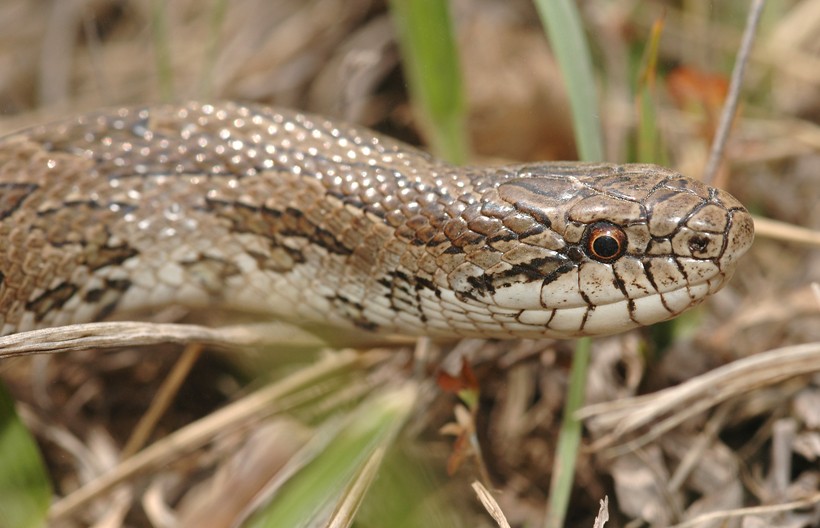
Closeup head Prairie Kingsnake
?
Image credits: Rusty Dodson/Shutterstock
- Prairie Kingsnake (Lampropeltis calligaster calligaster)
Found primarily throughout the Midwestern and Southeastern United States, from Nebraska to Virginia, Texas and Florida, this subspecies is the nominate form that has a light brown or grayish appearance and reddish brown blotching across its length. It is easily mistaken for a species of the rat snake because of its markings and the fact that it shares its habitat with a few species of the genus Pantherophis.
- Mole Kingsnake (Lampropeltis calligaster rhombomaculata)
This subspecies of the Prairie Kingsnake can be found throughout the southeastern United States and the Mid-Atlantic States preferring a habitat that consists of pasture lands, mostly pine lands or open fields. It is generally light brown in color with dark brown or reddish-orange blotching. It is easily mistaken for a milk snake or the venomous copperhead but is, in fact, a non-venomous constrictor.
- South Florida Mole Kingsnake (Lampropeltis calligaster occipitolineata)
The South Florida Mole Kingsnake is a secretive snake that is found only in Peninsula. The ground color of this snake is grayish to tan orange with post ocular stripes the same color as its dark brown or black blotches that run above its cream colored belly.
Found primarily throughout the Midwestern and Southeastern United States, from Nebraska to Virginia, Texas and Florida, this subspecies is the nominate form that has a light brown or grayish appearance and reddish brown blotching across its length. It is easily mistaken for a species of the rat snake because of its markings and the fact that it shares its habitat with a few species of the genus Pantherophis.
This subspecies of the Prairie Kingsnake can be found throughout the southeastern United States and the Mid-Atlantic States preferring a habitat that consists of pasture lands, mostly pine lands or open fields. It is generally light brown in color with dark brown or reddish-orange blotching. It is easily mistaken for a milk snake or the venomous copperhead but is, in fact, a non-venomous constrictor.
The South Florida Mole Kingsnake is a secretive snake that is found only in Peninsula. The ground color of this snake is grayish to tan orange with post ocular stripes the same color as its dark brown or black blotches that run above its cream colored belly.
Feeding Habits
The Prairie Kingsnake is a diurnal hunter that remains active mostly during the day. When the temperature is warm, the snake can be found basking on rocky surfaces. However, as the temperature drops in winter this species will slip inside crevices and animal burrows to hibernate until next spring.
The snake can eat a variety of prey, usually consisting of small mammals like rats and mice, lizards and bird eggs. It prefers a warm-blooded prey as compared to a cold blooded animal especially since it is an active forager. The Prairie Kingsnake can catch the scent of its potential prey and follows it relying on its tongue to enhance its sensing capabilities.
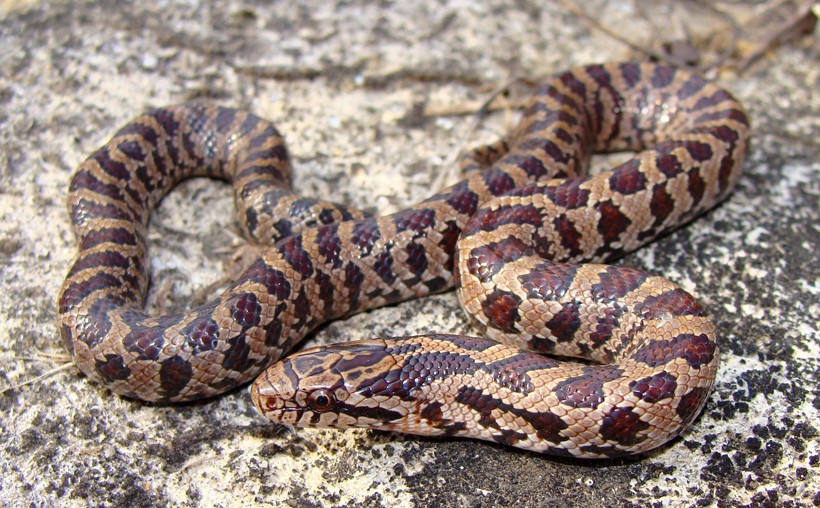
Red prairie kingsnake basking on a rock
?
Image credits: Matt Jeppson/Shutterstock
It is a constrictor which means that it seizes its prey in single or multiple strikes. Once it catches its prey it suffocates it to death breaking several bones and decapitating the prey.
Reproduction
Not much is known regarding the mating rituals of the Prairie Kingsnake except for the fact that the species is oviparous. The species begins mating during early spring around the month of April and usually lays eggs by June – July. The mating is generally single paired which means the male and female Kingsnake will mate for life instead of mating with multiple partners. The female Prairie Kingsnake releases a certain pheromone when she reaches sexual maturity which is detected by potential Kingsnake males in the surroundings.
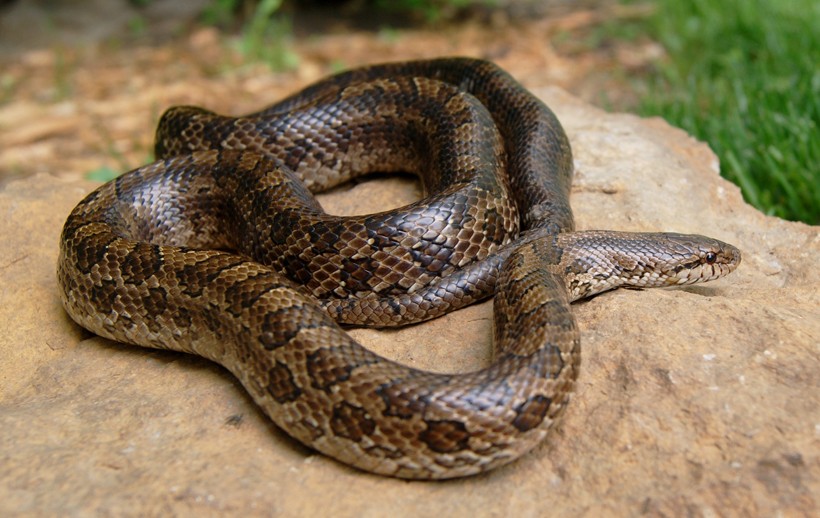
Prairie Kingsnake
?
Image credits: Matt Jeppson/Shutterstock
The female Prairie Kingsnake builds a nest made from fallen leaves and debris usually under rocks, logs or sawdust piles. The average clutch size is around 5 – 17 eggs with the eggs adhering to each other. The hatchlings that are born are independent at birth and bear similar markings or dark blotches across their skin like adults.
Behavior
With blocky brown markings and a sturdy built, the Prairie Kingsnake is one of the common snakes found in the southeastern United States, Nebraska, Virginia, Midwestern Texas and Florida. It is generally a shy and secretive species that is active during the day if the temperature is suitable, especially around the breeding season.
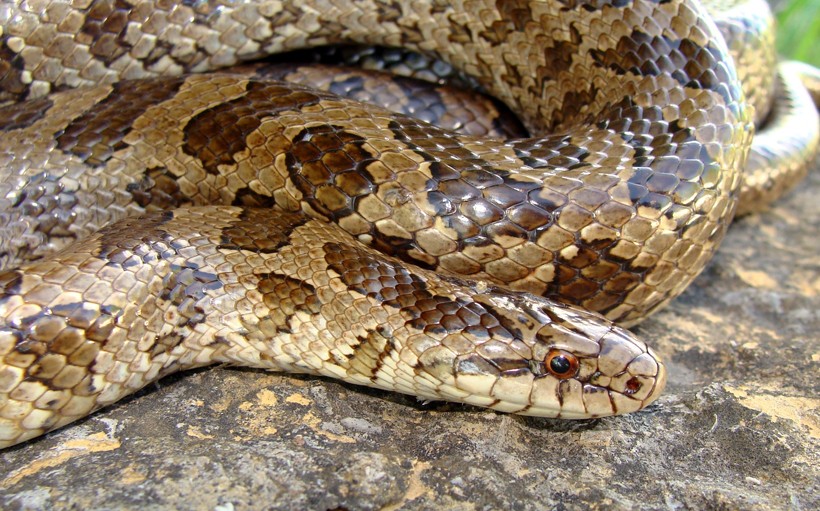
Prairie Kingsnake head
?
Image credits: Matt Jeppson/Shutterstock
They normally build their nests in an ecosystem that is close to a water body preferring a grassland community or a forested enclosure. They are non-venomous snakes that showcase an unusual adaptation which is the rattle. Kingsnakes shake their tails if harassed emitting a rattling sound against dry litter that sounds quite similar to a rattlesnake’s rattle. When they feel threatened they flatten their bodies and then it appears that they have white spots which are a form of defensive mimicry to escape predators. The species is immune to the venom of several species of snakes like copperheads and cottonmouths.
Funfacts
- The Prairie Kingsnake emits a foul smelling musk when it feels threatened and may coil or vibrate its tail in apprehension.
- The Prairie Kingsnake has a slender shaped body which helps it to slink away in the grass without being heard while searching for prey.
- The teeth of the Prairie Kingsnake are pointed backwards which helps to keep the prey moving in one direction.
- During summer season, the Prairie Kingsnake becomes a nocturnal hunter.
- During summer season, the Prairie Kingsnake becomes a nocturnal hunter.
- The female Prairie Kingsnake leaves her clutch right after the eggs hatch.
- The Prairie Kingsnake is ecologically significant because it kills rodents and other venomous snakes as well.
- According to the IUCN Red List, the Prairie Kingsnake currently has been listed as Least Concern since its population is stable.
